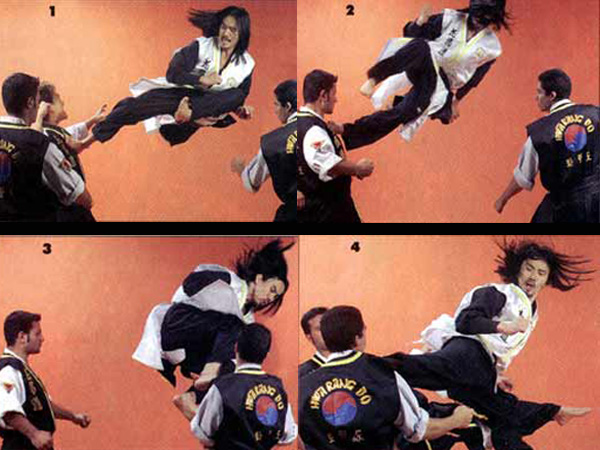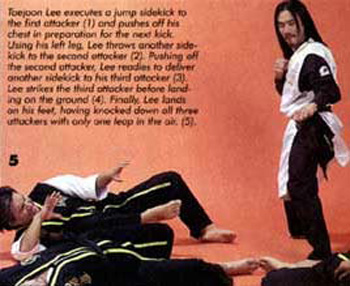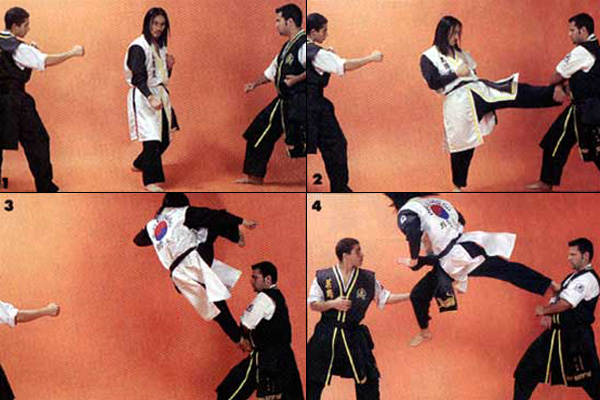Extreme Hwa Rang Do®
This Korean Art’s Aerial Kicks Push the Human Body to Find The Maximum Range of Physical Expression Part 1 by Hyung-Min Jung.
In the past few years, the hwa rang do system has stayed out of the spotlight. But that dormancy has come to pass, and hwa rang do is coming out of its cave like a hungry tiger with an appetite for conquest. At the forefront of that charge is Taejoon “Henry” Lee, the elder son of hwa rang do’s founder, Dr. Joo Bang Lee.
Taejoon Lee is one of the most colorful figures of Korean martial arts, and his insights into the system founded by his father are no less exciting than the man himself.
“Hwa rang do is a compilation of my fathers martial expertise that came on the scene in the 1960s in Korea,” explains Lee. “Many people look at some of the techniques that Korean martial arts are known for, and they credit them to styles like taekwondo and hapkido, but the reality is that many of those techniques showed up in other systems after my father started teaching publicly in Seoul. From Seoul, the instructors that trained under my father spread out to influence other systems and schools.”
KOREAN FOOT-FEST
One such branch of techniques is the amazing aerial kicking that the Korean martial arts are well known for, and hwa rang do kicking in particular may be indeed at the vanguard of the Korean foot-fest.
“If people just talked to anyone who trained with my father back in the 1950s and 1960s, they’ll know that hwa rang do practitioners were doing some of the 540 and 720 spin and combination kicks that some tournament forms competitors started doing only in recent years,” says Lee. “When I was a little kid back in Korea, there used to be footprints on the ceiling of my fathers Dojang (martial arts school) from the jumping dora chagi (spinning kicks) that his students used to practice.”
“Hwa rang do’s radical flying foot attacks fall under the heading of tuk soo jok sul or special kicking methods. Within tuk soo jok sul, there are a wide variety of kick attacks. Including in this category are jumping kicks, spinning jump kicks, flip kicks, flying kicks and kicks to multiple targets while airborne. This kind of extreme kicking is in keeping with hwa rang do’s philosophy of pushing the human body to find the maximum range of physical expression.
Careful consideration is required before “jumping” into this kind of training. According to Taejoon Lee, “people have to realize that this kind of training isn’t for everyone. The Hwarang warriors were the elite soldiers in ancient Korea, so they trained and developed skills that nobody else could do. Part of the reason that these Hwarang warriors were so feared is that during the time when Silla people fighting to unite Korea, their Hwarang knights would leap into the air and kick the mounted enemy soldiers off their horses. One of the most famous warriors in Korean history was named Kwan Chang. During the war with the Baekche tribe, Kwan Change leapt into the air and killed a mounted Baekche cavalry commander with a kick!”
SERIOUS INJURIES
But as a result of attaining such height, there is also a long drop back to the ground. This is where a great deal of injuries can occur with martial artists. There are countless incidents where aspiring martial arts students are sidelined by serious knee of ankle injuries sustained while practicing jumping kicks. Yet Lee has a quick answer for this situation.
“Injuries are a mark of something missing in the training, whether it be an issue of technical explanation, proper demonstration or safety precautions,” he says. “In many cases, it’s a situation in which the student isn’t taught the proper method for jumping and landing. Anyone can jump up high with a little practice, but are they prepared for the landing?”
RIGOROUS TRAINING
To prepare his students, Lee has a rigorous training regimen that builds muscular strength to attain height for the jump and power for the kick, while also building ligament and tendon strength to be able to absorb the impact from the landing. He begins from the most simple duck-walk drills to build leg strength and progress to practicing the components of the most complicated of hwa rang do’s kicks.
Following are some tips that are really important to remember when you’re jumping and landing, explains Lee.
You have to land “like a cat, not like a sack of bricks,” he says.
Your feet should touch the ground toe first, then follow with the heel.
Some people land heel first after jumping kick, and the shock of those landing goes straight up their legs to their kneed. If you land with your forefoot first, the ankle and knee together will absorb a lot more shock and give your body more time to decelerate. That prevents the kind of jarring injuries sustained most of the time with jumping kicks.
Also, it is important to tighten your dan jun or lower abdomen when you’re performing these jump kicks. When you tighten your lower abdomen, it’s like you’re making you body more compact, lighter, so that when you jump and spin, your center of mass isn’t spread out all over the place. When your center of mass is smaller, it’s easier for you to maintain your proper posture and positioning in the air, much like it is when you see a professional figure skater do a jumping spin and land on the ice.
JUMPING, FLYING KICKS
Once the basic jumping and landing skills have been mastered, the next step for a hwa rang do student is to progress through a series of jumping and flying kicks, starting from the simple standing jump kicks, to the flying single kicks (usually for breaking), and then aerial combinations kicks. Lee was one of the first martial artists in the United States to popularize the flying sidekick breaking techniques, taking a running leap over several people to shatter a stack of boards. The aerial combination kicks progress in difficulty from double jumping front kicks (where both legs kick out at two separate targets simultaneously), to combination kicks in which the kicker strikes and opponent three times after leaving the ground.
Another type of tuk soo jok sul is the wol jang jok sul or kicking techniques after stepping or pushing off an object with the foot.
“You know the kicks you see a lot of action stars doing in films?” asks Lee. “In hwa rang do, we do many of those same kicks that you see on the screen, but without the wires to hold us up.”
To emphasize his point, Lee stands up and positions two of his students with kicking targets, one at chest height and the other at head height. He sprints towards the wall, leaping up and pushing off the wall with one foot, changing direction towards the first target and kicking solidly with his other foot. With the same foot, he spins in midair and nails the second target-some six feet away from the first target-with a spinning round kick before alighting on the mat again.
“That’s the essence of wol jang jok sul, says Lee. “We use this kind of foot technique to attack multiply targets and change direction in midair. At the beginning levels, students learn to take a few steps off a wall and then push off the wall to kick a target that’s a few feet away from it. Later on, at higher levels, we can use an aerial kick as a means to change direction and strike the next target. Just know you saw me jump up the wall and hit the first target using the wall as a means to push off and change direction, but I used the force from the first kick to propel me backward so I could kick the second target.”
Such flying techniques may seem almost unbelievable to the untrained observer, but this kind of technique is simple physics, biased on inertia-the propensity of an object in motion to remain in motion and an object at rest to remain at rest. Each time the foot touches a stationary object; there is resistance to motion. For instance, when Lee begins to sprint towards the wall, his body is accelerated into motion. When it hits the first target, the target provides resistance against which his kick pushes to propel him backward and upwards into the next target. However, don’t let the simplistic explanation fool you. There is a great deal of physical coordination required for such maneuvers.
ASKING FOR TROUBLE?
This kind of kicking may seem as if it would offer ample opportunity for an opponent to grab an outstretched leg, but Lee merely grins at the suggestion.
“If someone were lucky enough to grab a leg, part of wol jang jok sul training is to use the free leg to kick your opponent with a telling blow, and free your leg,” says Lee. “In addition, we set up our aerial spinning kicks, like the 540’s with both legs, using one leg when you first leave the ground to gage the distance or create a diversion, and the second kick has the finishing power from the spin.”
“Agility is defined as the ability to change directions rapidly,” he continues. “Wol jang jok sul requires a great deal of agility – twisting the upper body, balancing in mid-air, and torque from the waist – to create the proper angle and motion for that kind of aerial combination kicking. We are basing out movements one the harmonized motion of proper breathing, leg strength, waist twisting and torso alignment to create powerful movement in different directions while airborne. Its physics combined with ki power to make the body lighter is such a way as to facilitate the jump and following kick. That’s the wirework you see in movies, but done in real life, with real kicks and real people. This is part of hwa rang do’s basic philosophy of maximizing human potential. It’s not just about training the simplest techniques for combat, but more to challenge yourself to achieve options that are unthinkable for the average person.”




